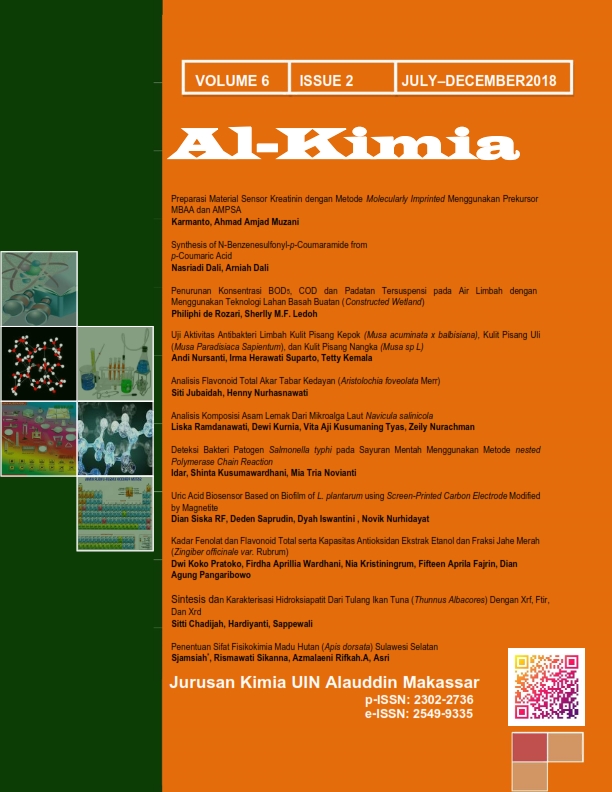Aktivitas Antibakteri dan Uji Fitokimia Senyawa Metabolit Sekunder dari Limbah Kulit Pisang Kepok (Musa acuminata x balbisiana), Kulit Pisang Uli (Musa Paradisiaca Sapientum), dan Kulit Pisang Nangka (Musa sp L)
Abstract
The study aimed to determine the secondary metabolites contained in raw banana peel waste, and to test the inhibitory activity in bacteria. Banana skin waste is used namely; banana kepok (Musa acuminata x balbisiana), uli banana (Musa paradisiaca sapientum) and nangka banana (Musa sp L) extracted using distilled water with the dekok method. The phytochemicals and antibacterial activity were tested for Staphylococcus aureus (S. aureus) and Escherichia coli (E. coli). Phytochemical test results showed the three banana peel extracts contain the same compounds, namely alkaloids, flavonoids, saponins, tannins and phenols. Different content of kepok banana peel extract is triterpenoid compounds which are not possessed by uli banana peel extract or banana jackfruit extract. The higher the concentration of extract used, the greater the inhibitory power of the bacteria. Antibacterial test results showed that 25% concentration of uli banana peel had the best antibacterial inhibition on S. aureus bacteria compared with kepok banana peel extract and jackfruit banana could not inhibit the growth of E. coli bacteria.
Downloads
References
Abdi, C. Khair, RM. & Saputra, MW. (2015). Pemanfaatan limbah kulit pisang kepok (musa acuminate l.) sebagai karbon aktif untuk pengolahan air sumur kota banjarbaru :fe dan mn. Jurnal teknik lingkungan. 1(1): 8
Chabuck, Z. Al-charrakh, A. Hindi, N. & Hindi, KK. (2013). Antimicrobial effect of aqueous banana peel extract, iraq. Pharmaceutical Sciences, 1 : 73-75
Franco, PB. de Almeida, LA. Marques, RFC. Brucha, G. Campos, MGN. (2016). Evaluation of antibacterial activity of chitosan membranes associated to unripe banana peel . I J Poly Sci. 859–863. doi:10.4028/ MSF.
Hanum, F. Tarigan, MA. Kaban, IMD. (2012). Ekstraksi Pektin dari Kulit Buah Pisang Kepok (Musa Paradisiaca). J Tek Kim USU
Harborne JB. (1987). Metode Fitokimia. Iwang S, penerjemah. Bandung (ID): ITB Press. Terjemahan dari: Phytochemical Method
Hidayat, R. Setiawan, A. & Nofyan, E. (2016). Pemanfaatan limbah kulit pisang lilin (musa paradisiaca) sebagai pakan alternatif ayam pedaging (gallus galus domesticus). Jurnal ilmu lingkungan, 11-17.
Lee, E-H. Yeom, H-J. Ha, M-S. Bae, D-H. (2010). Development of banana peel jelly and its antioxidant and textural properties. Springer Food Sci Bioctecnol. 19(2) : 449-445. doi: 10.1007/s/10068-010-0063-5.
Madigan, M. (2005). Brock Biology of Microorganisme. Hlmn :753. London: PrenticeHall.
Mohapatra, D. Mishra, S. Sutar, N. (2010). Banana and its by-product utilisation : an overview. J sci Inde Res. 69: 323-329.
Nurhayati, L. Waryanto, B. Rohmah. Y. Suwandi, Victor. (2016). Outlook komoditas pisang. Pusat Data dan Sistem Informasi Pertanian Kementerian Pertanian ISSN : 1907-1507
Pankey, GA. & Sabath, LD. (2004). Clinical relevance of bacteriostatic versus bactericidal mechanisms of action in the treatment of gram-positive bacterial infections. Clinical infectious diseases, 38, 864-870.
Pelczar, MJ. Chan, ECS. (1988). Dasar-dasar Mikrobiologi. Hadioetomo, penerjemah. Jakarta: UI Pr Terjemahan dari: Element of Microbiology.
Phuaklee, P. Ruangnoo, S. Itharat, A. (2012). Anti-inflammatory and antioxidant activities of extracts from musa sapientum peel. J Med Assoc Thai. 95(1): S142-S146
Piarah. Wahyu, H. Djafar, Z. & Mangkau, A. (2011). Analisis penggunaan gasohol dari limbah kulit pisang terhadap prestasi mesin motor bakar bensin. Jurnal mekanikal. 2: 39 - 52
Purwanto, A. (2012). Produksi nata menggunakan limbah beberapa jenis kulit pisang. Widya warta. ISSN 0854-1981
Supriyanti, FMT. Suanda, H. Rosdiana, R. (2015). Pemanfaatan ekstrak kulit pisang kepok (musa bluggoe) sebagai sumber antioksidan pada produksi tahu. Seminar nasional kimia dan pendidikan kimia vii p.mipa fkip uns; 2015 Apr 18; Surakarta, Indonesia: F.MIPA FKIP UNS. 393-400.
Siddique, S. Nawaz, S. Muhammad, F. Akhtar, B. & Aslam, B. (2018). Phytochemical screening and in-vitro evaluation of pharmacological activities of peels of musa sapientum and carica papaya fruit. Natural product research, 32: 1333-1336.
Tritanti, A. & Pranita, I. (2015). Limbah kulit pisang sebagai alternatif pengganti pewarna sintetis pada bedak tabur. Jurnal pendidikan teknologi dan kejuruan, 339-349.
Copyright (c) 2018 Andi Nursanti, Irma Herawati Suparto

This work is licensed under a Creative Commons Attribution-NonCommercial-ShareAlike 4.0 International License.
Authors who publish with this journal agree to the following terms:
1) Authors retain copyright and grant the journal right of first publication with the work simultaneously licensed under a Creative Commons Attribution License that allows others to share the work with an acknowledgement of the work's authorship and initial publication in this journal.
2) Authors are able to enter into separate, additional contractual arrangements for the non-exclusive distribution of the journal's published version of the work (e.g., post it to an institutional repository or publish it in a book), with an acknowledgement of its initial publication in this journal.
3)Authors are permitted and encouraged to post their work online (e.g., in institutional repositories or on their website) prior to and during the submission process, as it can lead to productive exchanges, as well as earlier and greater citation of published work (See The Effect of Open Access).


